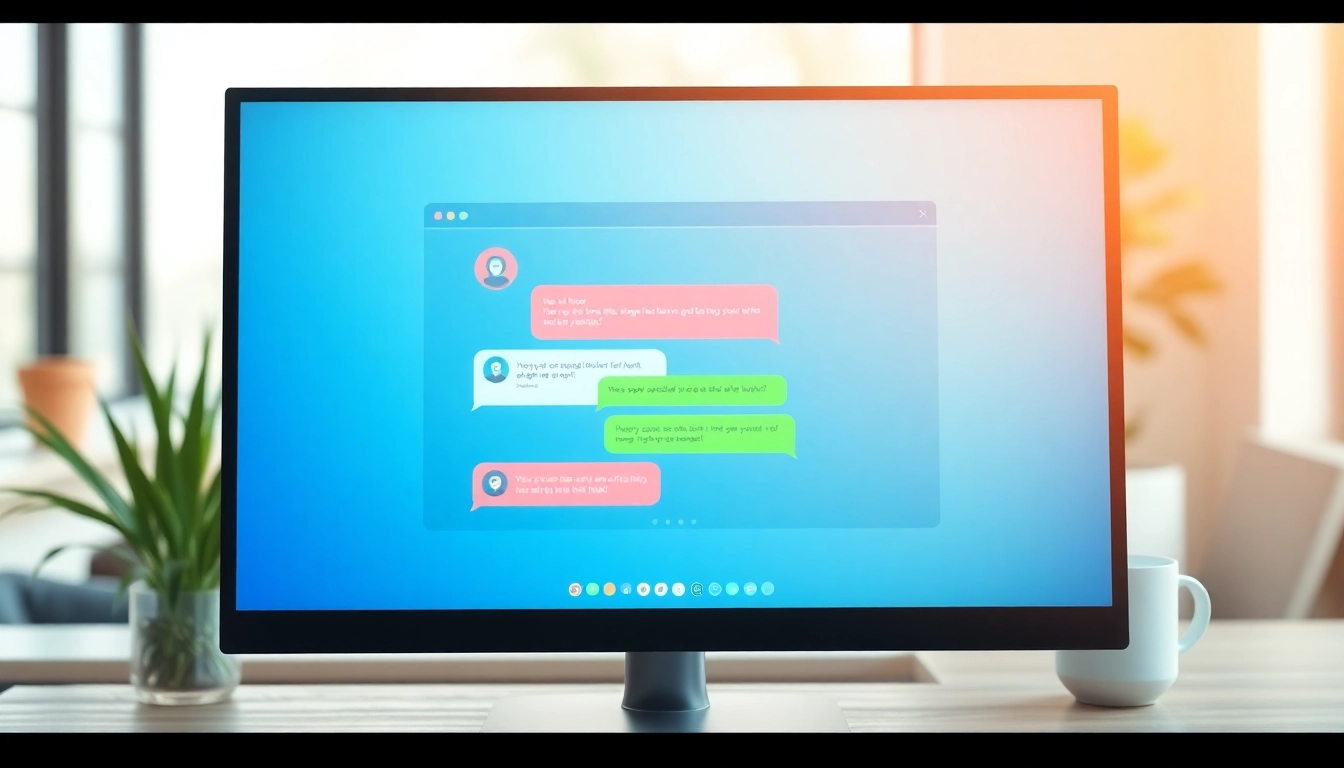
Understanding the Benefits of a Chatbot for Website
In today’s digital landscape, businesses are continually looking for ways to enhance user experience and streamline operations. One innovative solution that has gained tremendous popularity is the implementation of a chatbot for website. These automated conversational agents not only improve customer engagement but also provide valuable insights that can drive business decisions. In this article, we will explore the myriad benefits of chatbots, delve into how they function, and examine their potential to enhance customer support and boost sales.
What is a Chatbot and How Does it Work?
A chatbot is a software application designed to simulate human conversation through text or voice interactions. They can be integrated into messaging platforms, websites, or mobile applications. Chatbots operate using a combination of artificial intelligence (AI), natural language processing (NLP), and machine learning (ML) to interpret user input and provide relevant responses. This technology allows chatbots to understand context, handle multiple inquiries simultaneously, and learn from interactions to improve their accuracy over time.
Improving Customer Support with a Chatbot
One of the primary advantages of chatbots is their ability to enhance customer support. Traditionally, customer service requires significant human effort, with agents needing to be available around the clock to address inquiries. A chatbot can alleviate this burden by providing instant responses to FAQs and common issues. This means customers receive timely support even outside of typical business hours, leading to increased satisfaction and loyalty. Furthermore, chatbots reduce response time and eliminate long wait times commonly associated with live customer support.
Boosting Engagement and Sales Using a Chatbot
Chatbots can also effectively boost engagement and drive sales. By initiating conversations with website visitors, they can guide potential customers through the sales funnel. For instance, a chatbot can suggest products based on user preferences, answer questions about product features, and even facilitate transactions directly within the chat interface. This personalized approach not only enhances the customer’s shopping experience but also significantly increases conversion rates, as customers feel more supported and informed throughout their purchase journey.
Choosing the Right Chatbot for Your Website
Selecting the ideal chatbot for your website involves careful consideration of various factors, including the platform’s capabilities, user experience, and cost. To ensure you make an informed choice, it’s important to evaluate different platforms, key features, and integration options available.
Evaluating Different Chatbot Platforms
When exploring chatbot platforms, consider the scalability and flexibility of each solution. Some of the leading platforms, such as Intercom, Drift, and Button, offer an array of customizable features tailored to different business needs. Take advantage of trial periods and demos to assess the functionality and ease of use of each platform. Furthermore, customer reviews and case studies can provide valuable insights into how others have successfully implemented chatbots in their organizations.
Key Features to Look for in a Chatbot
To maximize the effectiveness of your chatbot, focus on key features that enhance functionality and user engagement. Important features include:
- Natural Language Processing (NLP): A robust NLP engine allows the chatbot to understand a wide range of user inputs and develop contextually aware responses.
- Multi-channel Support: Ensure the chatbot can operate across various platforms, including websites, social media, and messaging apps.
- Chat Analytics: Advanced analytics tools enable you to track user interactions, preferences, and pain points, assisting in continuous improvement.
- Integration Capabilities: The ability to integrate with CRM, e-commerce, and support systems enhances the chatbot’s functionality and offers a seamless user experience.
Integrating a Chatbot with Existing Systems
Successful chatbot implementation goes beyond selecting the right platform; it involves seamless integration with your existing systems. Ensure that the chatbot can access necessary databases and APIs to retrieve relevant information. This integration can enhance the user experience by providing personalized responses based on customer history and preferences. Additionally, leverage existing customer support systems to facilitate handoffs between the chatbot and human agents when needed, ensuring that the user receives the best possible support.
Best Practices for Deploying a Chatbot on Your Website
Deploying a chatbot requires a thoughtful approach to maximize its effectiveness. By adhering to best practices, you can create a user-friendly experience that meets customer expectations and aligns with your business goals.
Setting Clear Objectives for Your Chatbot
Before launching your chatbot, establish clear objectives that align with your broader business strategy. Consider the specific problems you aim to solve, such as reducing response times, increasing lead generation, or improving customer satisfaction. By defining measurable goals, you can assess the chatbot’s performance and success over time, making necessary adjustments based on your objectives.
Designing Conversational Flows for User Satisfaction
The design of conversational flows plays a crucial role in user satisfaction. A well-structured conversation that anticipates user needs can significantly enhance the interaction quality. Here are some considerations when crafting conversational flows:
- Context Awareness: Ensure the chatbot maintains context throughout interactions, making the conversation feel natural and personalized.
- Proactive Engagement: Encourage user engagement by initiating conversations or offering help based on site behavior.
- Clear and Simple Language: Opt for easily understandable language to accommodate users of varying technical abilities.
Testing and Improving Chatbot Performance
Regular testing and iterations are key to maintaining a high-performing chatbot. Monitor user interactions meticulously, collecting feedback and identifying patterns that require attention. Implement A/B testing to evaluate different conversational approaches, messages, and responses. By continually refining your chatbot based on data-driven insights, you can ensure it remains relevant and effective for users.
Measuring the Impact of Your Chatbot for Website
Assessing the performance of your chatbot is crucial to understanding its impact on overall business objectives. By leveraging analytics tools and key metrics, you can derive actionable insights that inform future strategies.
Analytics Tools for Chatbot Performance Measurement
Several analytics tools offer the capability to track and analyze chatbot interactions. These include Google Analytics, Chatbot-specific dashboards, and CRM systems. Monitoring user data can help identify engagement trends, drop-off points, and general satisfaction levels. By combining qualitative and quantitative data, you gain a holistic view of performance.
Key Metrics to Track for Success
To effectively measure success, focus on critical metrics such as:
- Response Rate: The percentage of inquiries successfully addressed by the chatbot without human intervention.
- User Engagement: Metrics related to user interactions with the chatbot, including the average length of conversations and the number of sessions initiated.
- Conversion Rate: The percentage of chatbot interactions that lead to a desired action, such as a sale or sign-up.
- User Satisfaction: Collect feedback through follow-up surveys to evaluate how well the chatbot meets customer expectations.
Adjusting Strategies Based on User Feedback
Feedback is a powerful tool in refining your chatbot strategy. Use customer surveys, ratings, and open-ended feedback to identify areas needing improvement. Additionally, keep an eye on user sentiment analysis to gauge overall satisfaction levels. Adapting your chatbot based on user insights fosters continuous improvement and ensures the service remains aligned with customer needs.
Case Studies: Successful Chatbot Implementations
Analyzing successful and failed implementations of chatbots can provide valuable lessons for businesses looking to adopt this technology. Here, we will explore various industry examples and the lessons learned from their experiences.
Industry Examples of Chatbot Integration
Many businesses have successfully integrated chatbots into their operations, demonstrating significant improvements in customer engagement and operational efficiency. For example, a leading e-commerce retailer incorporated a chatbot to guide users through the purchasing process. The result was a 25% increase in conversions and a notable reduction in cart abandonment rates. In the banking sector, banks have deployed chatbots to assist with account inquiries and service issues, leading to enhanced customer satisfaction scores and reduced handling times for support agents.
Learnt Lessons from Failed Implementations
Not all chatbot implementations yield positive results; some projects falter due to various factors, from poor design to lack of clear objectives. A notable example is a large telecommunications provider that deployed a chatbot without adequately training it on specialized terminology and customer expectations. Users found the chatbot frustrating and unhelpful, leading to general discontent and significant investments in fixing the issues. This highlights the importance of thorough testing, user feedback incorporation, and continuous enhancements post-launch.
Future Trends in Chatbot Technology
As technology continues to evolve, so will the capabilities of chatbots. Future trends may include:
- Voice Recognition: Enhanced voice interaction capabilities will allow users to engage with chatbots in a more intuitive manner.
- AI-driven Customization: Advanced AI may enable chatbots to learn individual user preferences over time, creating hyper-personalized experiences.
- Emotional Intelligence: Future chatbots may incorporate emotional analytics to better respond to user sentiments, leading to more empathetic interactions.
In conclusion, integrating a chatbot for your website can substantially improve user experience, operational efficiency, and customer satisfaction. By understanding the various functionalities and approaches outlined in this article, businesses can effectively harness the power of chatbots to drive growth and enhance customer services in a competitive digital landscape.







